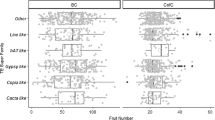Abstract
Methods are presented for calculating the number and type of different DNA sequences generated by base excision and insertion events at a given site in a known DNA sequence. We calculate, for example, that excision of the Mu1 transposon from the bz1::Mu1 allele of maize should generate more than 500,000 unique alleles given the extent of base deletion (up to 34 bases removed) and base insertion (0–5 bases) observed thus far in sequenced excision alleles. Analysis of this universe of potential alleles can, for example, be used to predict the frequency of creation of stop codons or repair-generated duplications. In general, knowledge of the distribution of alleles can be used to evaluate models of both excision and repair by determining whether particular events occur more frequently than expected. Such quantitative analysis complements the qualitative description provided by the DNA sequence of individual events. Similar methods can be used to evaluate the outcome of other cases of DNA breakage and repair such as programmed V(D)J recombination in immunoglobin genes.
Similar content being viewed by others
References
Blackman RK, Gelbart WM (1989) The transposable element hobo of Drosophila melanogaster. In: Berg DE, Howe MM (eds) Mobile DNA. American Society of Microbiology, Washington, D.C., pp 523–529
Britt AB, Walbot V (1991) Germinal and somatic products of Mu-1 excision from the Bronze-1 gene of Zea mays. Mol Gen Genet 227:267–276
Coen ES, Robbins TP, Almeida J, Hudson A, Carpenter R (1989) Consequences and mechanism of transposition in Antirrhinum Majus. In: Berg DE, Howe MM (eds) Mobile DNA. American Society for Microbiology, Washington, D.C., pp 413–436
Doseff A, Martienssen R, Sundaresan V (1991) Somatic excision of the Mu1 transposable element of maize. Nucleic Acids Res 19:579–581
Engles WR, Johnson-Schlitz DM, Eggleston WB, Sved J (1990) Highfrequency P element loss in Drosophila is homolog dependent. Cell 62:515–525
Fedoroff NV (1989) Maize transposable elements. In: Berg DE, Howe MM (eds) Mobile DNA. American Society for Microbiology, Washington, D.C., pp 375–411
Finnegan DJ (1992) Transposable elements. Curr Opinion Genet Dev 2:861–867
Gellert M (1992) Molecular analysis of V(D)J recombination. Annu Rev Genet 26:425–446
Levy AA, Walbot V (1991) Molecular analysis of the loss of somatic instability in the bz2::mu1 allele of maize. Mol Gen Genet 229:147–151
McClintock B (1984) The significance of responses of the genome to challenge. Science 226:792–801
Meier JT, Lewis SM (1993) P nucleotides in V(D)J recombination: a fine-structure analysis. Mol Cell Biol 13:1078–1092
Menssen A, Höhmann S, Martin W, Schnable PS, Peterson PA, Saedler H, Gierl A (1990) The En/Spm transposable element of Zea mays contains splice sites at the termini generating a novel intron from a dSpm element in the A2 gene. EMBO J 9:3051–3057
Moerman DG, Waterston RH (1989) Mobile elements in Caenorhabditis elegans and other nematodes. In: Berg DE, Howe MM (eds) Mobile DNA. American Society of Microbiology, Washington, D.C., pp 537–556
Plasterk RH (1991) The origin of footprints of the Tc1 transposon of Caenorhabditis elegans. EMBO J 10:1919–1925
Raboy V, Kim H.-Y, Schiefelbein JW, Nelson OE Jr (1989) Deletions in a dSpm insert in a maize bronze-1 allele alter RNA processing and gene expression. Genetics 122:695–703
Schwarz-Sommer Z, Gierl A, Cuypers H, Peterson PA, Saedler H (1985) Plant transposable elements generate the DNA sequence diversity needed in evolution. EMBO J 4:591–597
Sullivan TD, Schiefelbein JW Jr, Nelson OE Jr (1989) Tissue-specific effects of maize Bronze gene promoter mutations induced by Ds1 insertion and excision. Dev Genet 10:412–424
Takasu-Ishikawa E, Yoshihara M, Hotta Y (1992) Extra sequences found at P element excision sites in Drosophila melanogaster. Mol Gen Genet 232:17–23
Walbot V (1992) Strategies for mutagenesis and gene cloning using transposon tagging and T-DNA insertional mutagenesis. Annu Rev Plant Physiol Plant Mol Biol 43:49–82
Weil CF, Wessler SR (1990) The effects of plant transposable element insertion on transcription initiation and RNA processing. Annu Rev Plant Physiol Plant Mol Biol 41:527–552
Author information
Authors and Affiliations
Additional information
Communicated by A. L. Kahler
Rights and permissions
About this article
Cite this article
Nordborg, M., Walbot, V. Estimating allelic diversity generated by excision of different transposon types. Theoret. Appl. Genetics 90, 771–775 (1995). https://doi.org/10.1007/BF00222011
Received:
Accepted:
Issue Date:
DOI: https://doi.org/10.1007/BF00222011




